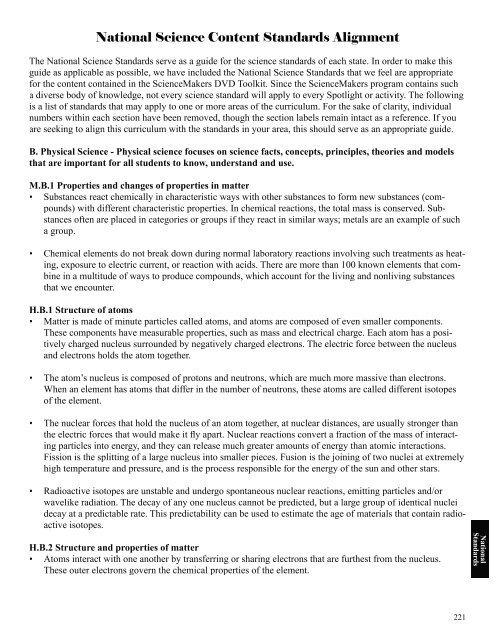ScienceMakers Toolkit Manual - The History Makers
ScienceMakers Toolkit Manual - The History Makers
ScienceMakers Toolkit Manual - The History Makers
You also want an ePaper? Increase the reach of your titles
YUMPU automatically turns print PDFs into web optimized ePapers that Google loves.
National Science Content Standards Alignment<br />
<strong>The</strong> National Science Standards serve as a guide for the science standards of each state. In order to make this<br />
guide as applicable as possible, we have included the National Science Standards that we feel are appropriate<br />
for the content contained in the <strong>Science<strong>Makers</strong></strong> DVD <strong>Toolkit</strong>. Since the <strong>Science<strong>Makers</strong></strong> program contains such<br />
a diverse body of knowledge, not every science standard will apply to every Spotlight or activity. <strong>The</strong> following<br />
is a list of standards that may apply to one or more areas of the curriculum. For the sake of clarity, individual<br />
numbers within each section have been removed, though the section labels remain intact as a reference. If you<br />
are seeking to align this curriculum with the standards in your area, this should serve as an appropriate guide.<br />
B. Physical Science - Physical science focuses on science facts, concepts, principles, theories and models<br />
that are important for all students to know, understand and use.<br />
M.B.1 Properties and changes of properties in matter<br />
• Substances react chemically in characteristic ways with other substances to form new substances (compounds)<br />
with different characteristic properties. In chemical reactions, the total mass is conserved. Substances<br />
often are placed in categories or groups if they react in similar ways; metals are an example of such<br />
a group.<br />
• Chemical elements do not break down during normal laboratory reactions involving such treatments as heating,<br />
exposure to electric current, or reaction with acids. <strong>The</strong>re are more than 100 known elements that combine<br />
in a multitude of ways to produce compounds, which account for the living and nonliving substances<br />
that we encounter.<br />
H.B.1 Structure of atoms<br />
• Matter is made of minute particles called atoms, and atoms are composed of even smaller components.<br />
<strong>The</strong>se components have measurable properties, such as mass and electrical charge. Each atom has a positively<br />
charged nucleus surrounded by negatively charged electrons. <strong>The</strong> electric force between the nucleus<br />
and electrons holds the atom together.<br />
• <strong>The</strong> atom’s nucleus is composed of protons and neutrons, which are much more massive than electrons.<br />
When an element has atoms that differ in the number of neutrons, these atoms are called different isotopes<br />
of the element.<br />
• <strong>The</strong> nuclear forces that hold the nucleus of an atom together, at nuclear distances, are usually stronger than<br />
the electric forces that would make it fl y apart. Nuclear reactions convert a fraction of the mass of interacting<br />
particles into energy, and they can release much greater amounts of energy than atomic interactions.<br />
Fission is the splitting of a large nucleus into smaller pieces. Fusion is the joining of two nuclei at extremely<br />
high temperature and pressure, and is the process responsible for the energy of the sun and other stars.<br />
• Radioactive isotopes are unstable and undergo spontaneous nuclear reactions, emitting particles and/or<br />
wavelike radiation. <strong>The</strong> decay of any one nucleus cannot be predicted, but a large group of identical nuclei<br />
decay at a predictable rate. This predictability can be used to estimate the age of materials that contain radioactive<br />
isotopes.<br />
H.B.2 Structure and properties of matter<br />
• Atoms interact with one another by transferring or sharing electrons that are furthest from the nucleus.<br />
<strong>The</strong>se outer electrons govern the chemical properties of the element.<br />
221<br />
National<br />
Standards










